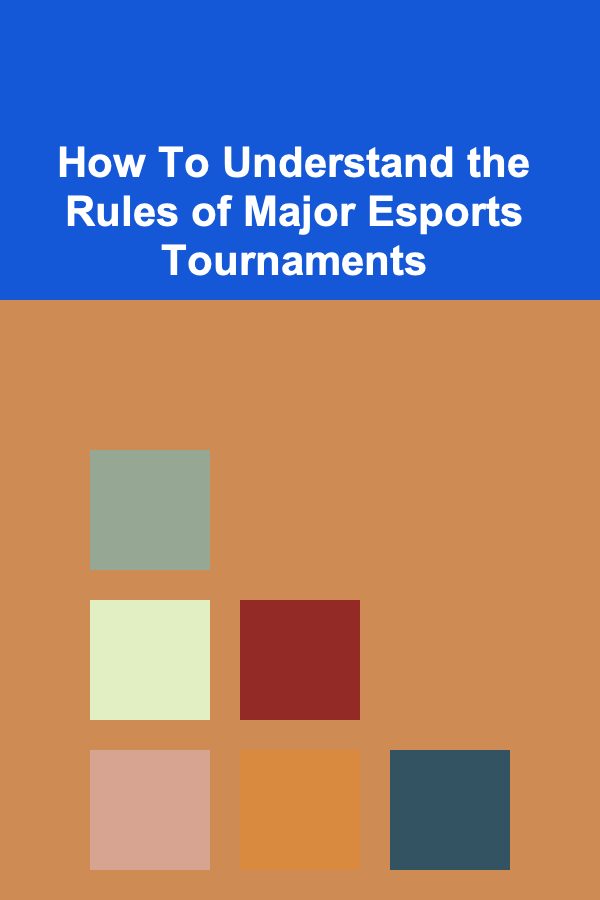
How To Understand the Rules of Major Esports Tournaments
ebook include PDF & Audio bundle (Micro Guide)
$12.99$5.99
Limited Time Offer! Order within the next:

Esports, or electronic sports, is one of the fastest-growing industries worldwide. As gaming continues to evolve into a professional, competitive environment, the structure of major tournaments has become more complex. Understanding the rules of major esports tournaments is crucial not only for players and teams but also for fans and viewers who want to fully immerse themselves in the esports world.
This article will dive deep into how to understand the rules of major esports tournaments. We'll cover the basics of how tournaments are structured, how different game genres approach their rulesets, and why the rules are critical to the integrity of competition. We will also explore the significance of these rules, how they evolve, and their role in shaping the esports landscape.
Understanding Tournament Formats
1.1 What is a Tournament Format?
In the context of esports, a tournament format refers to the structure and organization of a competition. It defines how matches are played, how teams or players are ranked, and how the winner is determined. The format is crucial because it directly influences the pace of the tournament, the type of matches players will face, and how viewers engage with the event.
1.2 Common Tournament Formats
There are several common formats in esports tournaments, each with its own set of rules and characteristics:
1.2.1 Single Elimination
The single-elimination format is one of the most straightforward formats used in esports. In this setup, teams or players are placed in a bracket, and the winner of each match advances to the next round. If you lose, you're out. This format is quick and can build a lot of tension, as one loss means elimination.
Example:
- League of Legends World Championship (in earlier rounds) follows this format, where losing teams are immediately eliminated from the tournament.
1.2.2 Double Elimination
Double elimination gives teams or players a second chance after a loss. If a team loses a match, they are placed in the losers' bracket, where they can still fight for a chance at the grand final. This format is used to ensure that the best teams or players, who might have suffered an early defeat, still have a path to redemption.
Example:
- Super Smash Bros. Ultimate tournaments often use this format.
1.2.3 Round Robin
In a round-robin format, each team or player competes against every other team or player at least once. The team with the most wins at the end of the round-robin phase is declared the winner or proceeds to the next stage. This format is often seen in group stages of large tournaments.
Example:
- The International (Dota 2) uses a round-robin format in its group stages.
1.2.4 Swiss System
The Swiss system is a hybrid between single and round-robin elimination. Players or teams play a set number of rounds, and after each round, they are paired with another team or player with a similar record. It avoids the issue of an early elimination but still maintains a competitive ranking system.
Example:
- Hearthstone Championship Tour (HCT) has often used a Swiss system format for its tournaments.
1.2.5 Best-of Formats
Esports tournaments often use best-of formats to determine the outcome of a match. These can range from a "best of 1" (where the first team to win one game wins the match) to "best of 5" or even "best of 7" matches in grand finals. The longer the series, the more room there is for players to recover from mistakes and showcase their skill over time.
Example:
- Overwatch League matches are typically best-of-5, but the grand finals are often best-of-7.
1.3 Game-Specific Formats
Each game has its own considerations when it comes to tournament formats. While some formats are universal, others are designed to fit the unique pace, length, and style of the game.
1.3.1 MOBA (Multiplayer Online Battle Arena) : Dota 2, League of Legends
MOBAs typically have long match durations and complex team dynamics. Their tournaments usually employ a combination of round robin for the group stages and elimination formats for the knockout stages.
1.3.2 FPS (First-Person Shooter) : Counter-Strike: Global Offensive, Call of Duty, Overwatch
FPS games often emphasize fast-paced action and team coordination. Tournaments might use best-of formats, double-elimination, or round robin stages. Additionally, FPS games often require specific maps and game modes to be adhered to, creating an additional layer of complexity to the rules.
1.3.3 Fighting Games : Street Fighter, Super Smash Bros.
Fighting games are traditionally simpler in structure but still require deep rule understanding. Most tournaments follow a single-elimination or double-elimination format, but some use pools or Swiss formats to accommodate a large number of participants. The rules governing character selection, stage choice, and specific in-game mechanics like combos and special moves are pivotal.
1.3.4 RTS (Real-Time Strategy) : StarCraft II
RTS games tend to focus on strategic decision-making over a longer period. These tournaments typically employ a mix of formats, with a focus on ensuring that both individual skill and long-term strategy are rewarded.
1.4 Regional Qualifiers and Global Finals
Some esports tournaments, particularly the larger international ones, will have regional qualifiers where players or teams must compete within their own regions to earn a spot in the global finals. These qualifiers often follow their own rules and formats, which may vary based on the region and the number of teams involved.
Example:
- The International (Dota 2) has regional qualifiers that lead to the main event, which involves teams from around the world competing for a spot in the grand finals.
Key Rules in Esports Tournaments
While tournament formats set the stage for the competition, the rules that govern gameplay are just as important in determining the outcome and fairness of matches.
2.1 Game Rules
Each esports title has its own set of in-game rules that must be adhered to during the tournament. These rules can cover a wide range of areas, including character abilities, item usage, map selections, and more. For example:
- In League of Legends, champions may be banned or picked during specific stages, and there are restrictions on certain items.
- In Counter-Strike: Global Offensive, the use of weapons and equipment is restricted to maintain balance.
- In Dota 2, the banning and picking of heroes occur in a draft phase, which requires strategy from both teams to outplay their opponents before the game even starts.
2.2 Tournament-Specific Rules
Beyond the game rules, every tournament has its own regulations. These can include:
- Time Limits: Tournaments often have time restrictions on matches or breaks.
- Seeding and Ranking: The process of seeding teams or players into brackets is essential to ensure fairness. Seeding is usually based on a combination of factors, such as past performances and rankings.
- Player Substitutions: Some tournaments allow teams to substitute players during matches or at certain points in the tournament, while others may have strict rules on player rosters.
2.3 Fair Play and Code of Conduct
Fair play is the cornerstone of any competitive tournament. To maintain fairness, many tournaments have strict codes of conduct and behavior. These codes outline acceptable and unacceptable actions during a tournament, including:
- Cheating: Any form of cheating, such as using unauthorized software or exploiting bugs, can result in disqualification.
- Unsportsmanlike Behavior: Abusive language, toxic behavior, or deliberate disruption of matches can result in penalties or bans.
- Team Integrity: In some tournaments, players may not be allowed to switch teams or sign contracts with competing organizations until after the tournament's conclusion.
2.4 Penalty and Disqualification
Esports tournaments are strict when it comes to violations of rules. If a team or player violates the rules, penalties can range from a warning to a disqualification. Common violations include:
- Using prohibited software or hardware.
- Unsportsmanlike conduct, including verbal abuse or cheating.
- Failure to show up for scheduled matches.
The Evolution of Esports Tournament Rules
3.1 Adapting to New Technologies
As esports continues to grow, the rules governing tournaments evolve. New technology, such as improved anti-cheat software or more efficient server infrastructure, requires the rules to be updated to ensure a fair and smooth competitive experience.
3.2 Evolving with the Game
Esports rules must also evolve with the games themselves. As developers release patches, balance updates, and new content, tournament organizers must decide how to incorporate these changes into their events. For example, a patch that nerfs a popular character or hero may require adjustments in the tournament's draft or banning phase.
3.3 Community Feedback
Another driving force in the evolution of rules comes from the community. Fans, players, and teams provide valuable feedback on the rules and formats, helping organizers adjust and improve future tournaments. This feedback loop has led to more diverse formats, better fair-play regulations, and smoother tournaments overall.
The Role of Referees and Officials
Referees and officials play a critical role in ensuring the rules are followed. They are responsible for overseeing matches, reviewing potential rule violations, and enforcing penalties. In high-stakes tournaments, referees are highly trained professionals who can resolve disputes, monitor the gameplay for signs of cheating, and make on-the-spot decisions to ensure fairness.
Conclusion
Understanding the rules of major esports tournaments is fundamental for both players and fans who want to engage deeply with the competitive gaming scene. The rules ensure fair play, maintain a level playing field, and keep the integrity of esports intact. While these rules can vary from tournament to tournament, knowing how tournaments are structured, what rules are in place, and how they evolve helps everyone involved appreciate the hard work, skill, and dedication required to succeed at the highest levels of competitive gaming. As esports continues to grow, so too will the complexity of its tournaments and the rules that guide them, but the core principles of fair play and sportsmanship will always remain the foundation of the scene.

How to Maintain Your Home's Bathroom Fixtures
Read More
How to Use Asset Allocation to Optimize Your Investment Portfolio
Read More
How to Use Indexing for Quick Document Retrieval
Read More
How to Use Tags and Labels for Better File Retrieval
Read More
How to Overcome Shyness When Speaking a New Language
Read More
How To Develop Your Unique Strengths
Read MoreOther Products

How to Maintain Your Home's Bathroom Fixtures
Read More
How to Use Asset Allocation to Optimize Your Investment Portfolio
Read More
How to Use Indexing for Quick Document Retrieval
Read More
How to Use Tags and Labels for Better File Retrieval
Read More
How to Overcome Shyness When Speaking a New Language
Read More